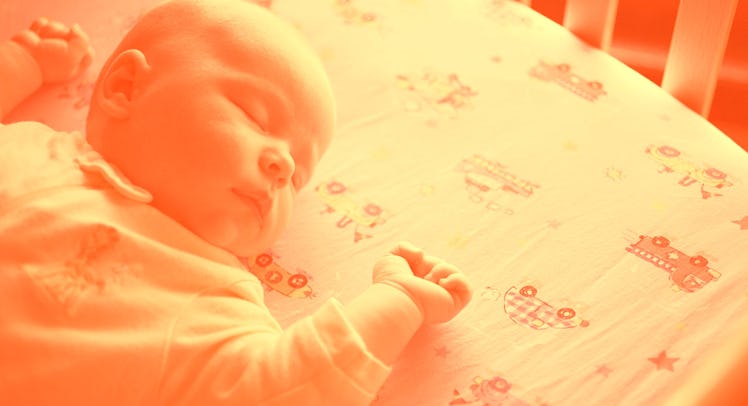How to Tell When It’s Safe to Use Bedding in Cribs
Blankets, pillows, and stuffed animals are risk factors for SUID, and are unnecessary anyway. As long as babies are warm enough, they don’t need them.

SIDS, or Sudden Infant Death Syndrome, is a nightmare scenario for parents. Unexplained deaths are horrific, and there’s no getting around that. In recent years, though, research by a wide variety of parties — investigators, medical examiners, and pediatricians — have identified certain risk factors. If these risk factors can be managed, then the odds of SIDS can be reduced.
“The things that create safe sleep environments also overlap a lot with preventing these unexplained deaths,” explains Elizabeth Murray, M.D., a pediatric emergency physician and spokesperson for the American Academy of Pediatrics. “So creating a safe sleep environment will also reduce risk factors for SIDS.”
READ MORE: The Fatherly Guide to SIDS
Sleep risk-factors tend to skew according to age and correlating ability. The greatest risk for the youngest infants — one to three months — is some kind of object or bedding in the crib, or being put into bed with a parent who is not nursing. Something as innocuous as a sheet or a blanket, even something light or gauzy, can suffocate an infant simply because they haven’t developed sufficient head control to move their face away from an obstruction. Sleeping on a couch or on a mattress that is too small for the crib can lead to a baby becoming trapped or smothered. Newborns should sleep on their backs on a firm mattress and have supervised tummy time during the day.
At four to five months, most babies are exercising more head control, but they are also attempting more types of movement. For an infant who can roll onto their side in one direction but can’t roll back, stuffed animals and pillows in the crib represent the greatest risk. Babies can roll themselves into danger without having the ability to roll away from it.
After six months the risk of suffocation or SUIDS is reduced greatly, although there are definitely still cases of SUID up to the first year of life, after that it is quite rare.
The obvious answer, then, is to forego bedding in the first year in favor of a fitted sheet. But parents shouldn’t use the first birthday alone to gauge if it is safe to introduce bedding to the crib. They need to assess their child’s abilities and developmental milestones.
If a child has control in a normal waking environment (they can roll, can sit up, can pull themselves up to stand, can move around with support, or even walk), it is probably safe to add some sort of bedding. But, honestly, as long as the child is warm enough, bedding is rather unnecessary. Footie pajamas, sleep sacks, and onesies are sufficient to keep a baby, even one 12 to 18 months old, comfortable and sleeping soundly.
“Very few babies in those one-to-two years of life are bothered by not having a pillow or a blanket,” says Murray. “There is a slight risk that exists even after a child turns one – so why are we adding those types of things anyway?”
A small stuffed animal or birth cloth for comfort is reasonable, provided they are able to meet all their milestones such as sitting, pulling to a stand, and move independently and don’t have other underlying medical issues or risk factors. Parents should note that just because the instances of SIDS decline after the first year, the importance of safe sleep doesn’t. Parents need to make sure that the fitted sheet in the crib is the right size and not likely to come loose. The mattress still needs to be the right size. If too small, then even strong, active babies can become trapped. In adjustable cribs, the mattress needs to be lowered to the safest height to prevent particularly intrepid one-year-olds from going over the railing. Cribs should be checked for recalls or design flaws — product recalls can be checked at the Consumer Product Safety Commission or Safe Kids Worldwide.
The specter of SUID — even when it doesn’t directly touch a family — is a prime example of how vulnerable people can become in parenthood. But there are steps parents can take to protect their children. Hopefully, they will.